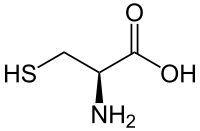Cysteine facts for kids
Cysteine (pronounced SIS-teen) is a very important amino acid. Think of amino acids as tiny building blocks. Our bodies use these blocks to make proteins. Proteins are super important for almost everything our bodies do, like building muscles and fighting off sickness.
Cysteine is special because it contains sulfur. This sulfur helps it do many important jobs in our bodies. It's often called Cys or C for short.
Contents
How Our Body Uses Cysteine
Our bodies can actually make cysteine! This means it's a "semi-essential" amino acid. We don't always have to get it from food, but eating foods rich in cysteine can still be helpful.
Building Strong Proteins
One of cysteine's most important jobs is helping proteins keep their shape. Cysteine molecules can link up with each other using their sulfur parts. This creates a strong connection called a disulfide bond. Imagine two hands holding tightly together! These bonds help proteins fold correctly and stay strong. This is super important for proteins like those in your hair and skin.
Protecting Your Body
Cysteine is also a key part of a powerful molecule called glutathione. Glutathione is like a superhero for your cells! It helps protect them from damage caused by harmful substances called free radicals. This protection is really important for keeping you healthy.
Helping Enzymes Work
Many enzymes in your body need cysteine to work properly. Enzymes are special proteins that speed up chemical reactions. Cysteine's unique structure helps these enzymes do their jobs, like breaking down food or making new molecules.
Where Can We Find Cysteine?
You can find cysteine in many foods. It's especially common in foods that are high in protein.
Cysteine in Food
Some good sources of cysteine include:
- Meat (like chicken and beef)
- Eggs
- Dairy products (like milk and cheese)
- Legumes (like lentils and beans)
- Whole grains
Cysteine as a Food Additive
Sometimes, cysteine is added to foods. When it's used as a food additive, it has a special code called E920. It can be used in things like bread dough to make it stronger and more elastic.
Images for kids
Quick facts for kids L-Cysteine |
|
|---|---|
 |
|
| IUPAC name | Cysteine |
| Other names | 2-Amino-3-sulfhydrylpropanoic acid |
| Except where noted otherwise, data are given for materials in their standard state (at 25 °C, 100 kPa) | |
See also
 In Spanish: Cisteína para niños
In Spanish: Cisteína para niños




